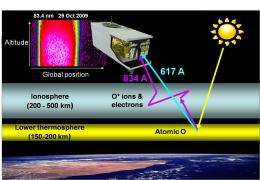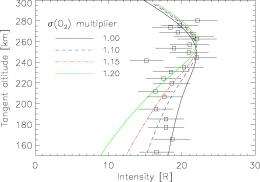NRL RAIDS experiment advances ionospheric remote sensing

Naval Research Laboratory scientists have obtained a first-ever measured altitude profile of a dim extreme-ultraviolet terrestrial airglow emission that provides vital information needed to test and improve the accuracy of advanced techniques for remote sensing of the daytime ionosphere. They have obtained this altitude profile using scans from the Remote Atmospheric and Ionospheric Detection System (RAIDS) experiment. The results of the research are published in the Journal of Geophysical Research, 117, A01316, (2012).
RAIDS temperature measurements have already directly contributed to the Calibration/Validation of the operational (NRL-led) Special Sensor Ultraviolet Limb Imager (SSULI) sensors aboard the DoD Defense Meteorological Satellite Program satellites. This new result from RAIDS will lead to improved operational algorithms for characterizing the vertical structure and global morphology of the ionosphere, the weakly ionized plasma surrounding Earth that affects Navy applications such as high-frequency communication and over-the-horizon radar.
The RAIDS experiment, jointly built by NRL and The Aerospace Corporation, is a suite of eight optical sensors spanning ultraviolet to infrared wavelengths. Under the direction of the DoD Space Test Program, RAIDS and the companion NRL Hyperspectral Imager for Coastal Oceans (HICO) experiment were integrated and flown as the HICO-RAIDS Experiment Payload (HREP) on the International Space Station Japanese Experiment Module-Exposed Facility (JEM-EF). RAIDS exceeded its mission goals by collecting over 1 million scans of the terrestrial airglow between September 2009 and December 2010, and has continued to collect downward-looking spectra since early 2011. RAIDS is the latest in a significant line of NRL Space Science Division (SSD) sensors designed to advance methods and algorithms for remote sensing of the near-Earth space environment.

One high-priority science focus of RAIDS was the development of new ionospheric remote sensing techniques that use extreme-ultraviolet airglow features of O+ at 61.7 and 83.4 nm wavelengths. These naturally-occurring airglow emissions are particularly useful for this purpose in that strong absorption of these wavelengths in the lower atmosphere means that all the observed light comes from the upper atmosphere. The emissions are created initially when the Sun ionizes atomic oxygen in the region of 150-200 km, but the resulting 83.4 nm photons are scattered by O+ in the ionospheric region between 200-500 km. Ionospheric densities are inferred by modeling how this scattering process changes the measured 83.4 nm intensity. In effect, the ionosphere is like a thin fog whose characteristics are revealed via illumination by the 83.4 nm airglow from below. The 61.7 nm feature, which is not affected by scattering, provides the missing link to directly connect the intensity of the illuminating source in the lower atmosphere to the measured 83.4 nm profile, allowing the O+ density to be pinpointed.
NRL Space Science Division (SSD) researchers Dr. Andrew Stephan and Dr. Scott Budzien, along with retired SSD researcher Dr. J. Michael Picone (now at George Mason University) and colleagues at The Aerospace Corporation, analyzed RAIDS data for 29 Oct 2009 to provide the first independent test of the model that is currently used as part of this daytime ionospheric remote sensing method. The data show good agreement with the model, although subtle differences suggest changes on the order of 15% to the densities of specific neutral species are needed on this day to bring the two into agreement. These small differences confirm the notion that uncertainty in the density of the neutral atmosphere remains an important limitation to high-accuracy ionospheric specification. Results from this study will be used to refine this ionospheric remote sensing technique and remove these limitations to meet the growing need for understanding this important region of space.
Journal information: Journal of Geophysical Research
Provided by Naval Research Laboratory


















